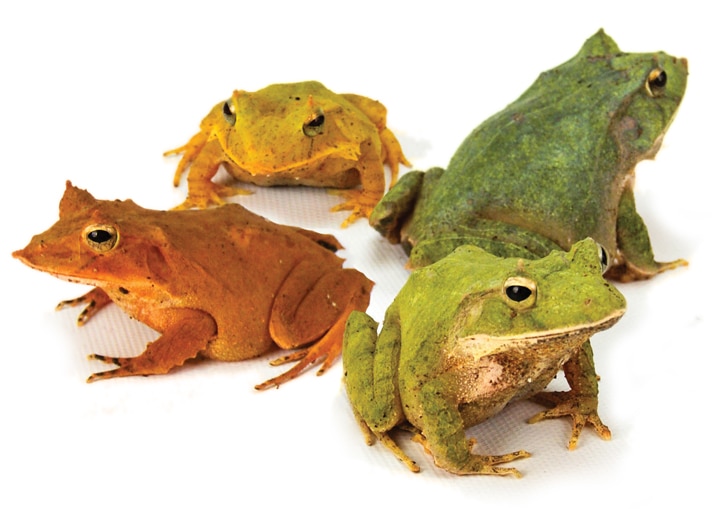Description:
A terrarium measuring 24 by 18 by 18 inches will house up to three adult frogs. You need to provide a roomy area so they won’t bang into the glass and hurt their noses. A 4-inch layer of ground coconut coir and cypress mulch can be used for bedding. Solomon Island horned frogs like to burrow to feel comfy, and some dried tropical leaves on top of the substrate will make them feel even more secure and gives a real rain-forest feel to the enclosure. Add a few nice pieces of cork bark and some live or good-looking plastic plants. The bedding should be completely replaced once every two months or so. Spot clean fecal material between changes. Include a good-sized water bowl that all the cage inhabitants can sit in, and your setup is complete. Solomon Island horned frogs are most comfortable at temps in the low 70s Fahrenheit; you can likely keep them at room tempeture and they will do swell. Use a low-level UV lamp to simulate a day/night cycle, 12 hours on and 12 hours off. As with most amphibians, humidity is critical for this frog’s health. A humidity level that’s between 60 and 75 percent is great. Maintain this by using a commercial humidifier sold in reptile stores, or you can hand mist the enclosure daily. The soil should be damp but not sopping wet. I like to keep the surface somewhat dry while the bedding just below the surface is damp. You can add water features such as a waterfall or other such decoration. The frogs will love it, and it will make their terrarium really stand out. The Solomon Island horned frog is an ambush hunter and will eat anything it can catch and swallow. Pets will relish crickets, Dubia roaches, earthworms and even small pinky mice. Feeding two to three times a week should keep them chubby and happy. Imports are sporatic and usually arrive in fairly good shape, but will need to be monitored for parasites and dehydration. Taking a new frog to a vet for a fecal exam is recommended. Captive breeding of Ceratobatrachus guentheri is becoming more frequent, and I recommend buying young captive-bred frogs if you get the chance. You can find Solomon Island horned frogs at specialty reptile stores, reptile shows and online in a variety of colors, ranging from light green to dark brown, and all are very handsome animals. Solomon Island Horned frogs have no tadpole stage. Fully formed, miniature frogs hatch from their eggs buried in the ground. If set up properly, Solomon Island horned frogs willl thrive. They do well in small groups or singly, and they are easy to maintain. They are super cool pet frogs. Ken Foose produced his first captive-bred snakes at age 11. With a Master’s Degree in zoology, he has been both a zookeeper and curator. He opened Exotic Pets, which specializes in reptiles and amphibians, in Las Vegas in 1991. He is currently president of the International Herpetological Symposium.
Habitat:
Tropical rain forests and secondary/modified forest areas
Range:
Throughout the Solomon Islands
Scientific Name: Ceratobatrachus guentheri
Species Group: frog
Family: Ceratobatrachidae
Size: N/A
Level: advanced
Weight: N/A
Dangerous: No



